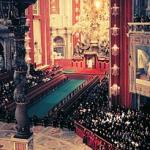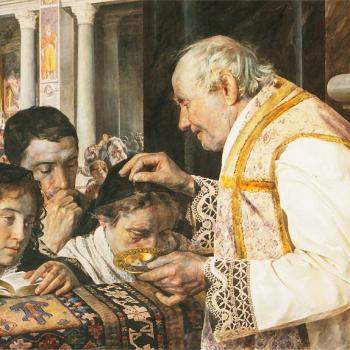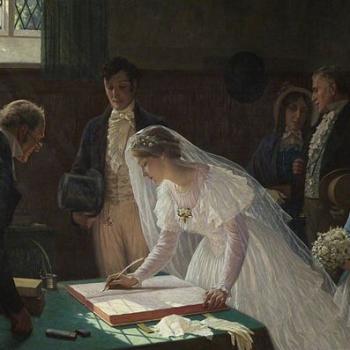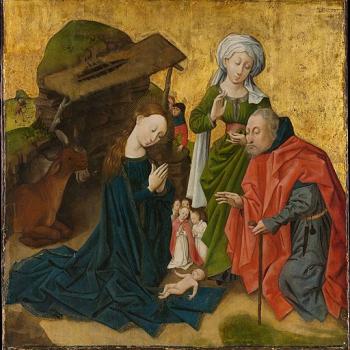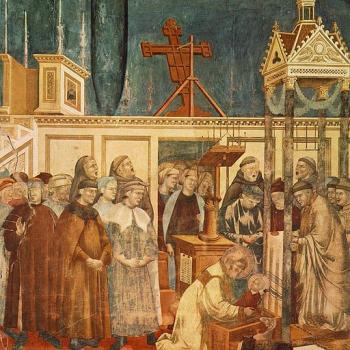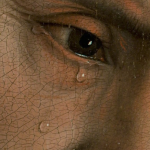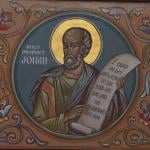This is the third of my ruminations on Gaudium et Spes, the Pastoral Constitution on the Church in the Modern World of Vatican II. You can read part one here and part two here. This post has been long delayed for a variety of reasons, so I am hoping to turn out several of these in short order to get caught up. For this discussion we read Chapters 1-3 of Part II of the constitution, paragraphs 46-72. This part of the document is devoted to “Problems of Special Urgency”, and treated marriage & the family (Chapter 1, 46-52), the development of culture (Chapter 2, 57-62), and economic and social life (Chapter 3, 63-72). We spent almost no time discussing the family, particularly questions related to overpopulation and family size. This came up in previous encyclicals, most recently Mater et Magistra and we passed over it then as well. However (spoiler alert!) we did talk about it when discussing Populorum Progessio, so stay tuned!
The bulk of our discussion was on the section on culture, and at the very end we began discussing social and economic issues, though mostly in relation to culture. One of the first things that we noticed was the openness that the Council fathers showed to world cultures. Gone is any tendency to divide the world into light and dark, advocating for a “Catholic culture” over and against a worldly one. Rather, the Church sees great value in modern culture, even while pointing out its faults and shortcomings. Speaking very broadly, GS argues that
When man develops the earth by the work of his hands or with the aid of technology, in order that it might bear fruit and become a dwelling worthy of the whole human family and when he consciously takes part in the life of social groups, he carries out the design of God manifested at the beginning of time… (par. 57b)
(I will come back to this definition of culture below.) The Church is called to engage with culture, particularly science and the arts. I was struck by the following description about the relationship between the Church and artists:
Literature and the arts are also, in their own way, of great importance to the life of the Church. They strive to make known the proper nature of man, his problems and his experiences in trying to know and perfect both himself and the world….Efforts must be made so that those who foster these arts feel that the Church recognizes their activity and so that, enjoying orderly liberty, they may initiate more friendly relations with the Christian community. The Church acknowledges also new forms of art which are adapted to our age and are in keeping with the characteristics of various nations and regions. (par. 62bc)
Though we read this section before the current tempest in a teapot about the Vatican nativity scene, as I write this I could not help contrast the way in which the Constitution is open to modern art with the reflexive, visceral denunciations of the current nativity scene as ugly, dark, demonic, and utterly lacking in any redeeming qualities and seemingly hostile to Christian virtue. (For the record, personal preferences are exactly that, and anyone is free to say they like or dislike this particular nativity. What puzzles me are the sweeping, universalist denunciations which seem to imply that not only does the speaker not like it, but no one else should either.) Embracing contemporary art, or even contemporary cultures, should not be down unthinkingly: not every culture is wholly good, and GS forcefully notes that a key requirement is that
culture is to be subordinated to the integral perfection of the human person, to the good of the community and of the whole society. (par. 59a)
But at the same time, the Church should free itself to learn, particularly from the sciences:
theologians, within the requirements and methods proper to theology, are invited to seek continually for more suitable ways of communicating doctrine to the men of their times; for the deposit of Faith or the truths are one thing and the manner in which they are enunciated, in the same meaning and understanding, is another. In pastoral care, sufficient use must be made not only of theological principles, but also of the findings of the secular sciences, especially of psychology and sociology, so that the faithful may be brought to a more adequate and mature life of faith. (par. 62a)
Reading this passage, I was reminded of the late Fr. Andrew Greeley. Greeley was a widely cited sociologist with dozens of books, but he always felt (and indeed at times had a chip on his shoulder about it) that the Church would not listen to social scientists. As noted in his obituary in the LA Times,
In 1972 he completed a two-year study that found widespread dissatisfaction among American priests. American bishops had helped fund the research but rejected its findings.
Though he did not always honor his own rule (this article from 2004 teeters on the brink), he repeatedly stated that his research was not to tell the bishops what they ought to teach, but rather to help them understand what was happening in the pews. I wonder if the post-Vatican II period might have played out differently had they accepted his data and acted on them.
In its discussion about culture, I was struck by the way in which GS (intentionally or not) touched on a then current debate about the “two cultures.” In a very influential and controversial lecture and book in 1959, The Two Cultures and the Scientific Revolution, British chemist and writer C.P. Snow argued that culture in the West had been split in two, separating science and mathematics from the humanities. He was critical of the disdain he felt that humanists had towards science and felt that education in both was required, and advocated for more scientific education. The Council fathers address this division directly, pointing out the dangers of the separation (though standing more on the side of humanists) and calling for bringing them together:
How is the dynamism and expansion of a new culture to be fostered without losing a living fidelity to the heritage of tradition. This question is of particular urgency when a culture which arises from the enormous progress of science and technology must be harmonized with a culture nourished by classical studies according to various traditions. How can we quickly and progressively harmonize the proliferation of particular branches of study with the necessity of forming a synthesis of them, and of preserving among men the faculties of contemplation and observation which lead to wisdom? (par. 56c)
Here, I think, we circle back to Andrew Greeley’s lament. The Church has a great deal to offer in terms of both historical memory and moral insight. If it were able to successfully interact with the scientific (both physical and social) discoveries of the present day, it could help shape a culture that
can both develop the whole human person and aid man in those duties to whose fulfillment all are called, especially Christians fraternally united in one human family. (par. 56f)
The Constitution is mindful of the dangers of scientism: the philosophical trend that argues that only science produces truth or meaning:
Indeed today’s progress in science and technology can foster a certain exclusive emphasis on observable data, and an agnosticism about everything else. For the methods of investigation which these sciences use can be wrongly considered as the supreme rule of seeking the whole truth. (par. 57e)
But, while standing for a broader and more inclusive definition of truth, one which admits a transcendent dimension, GS also takes pains to avoid an anti-scientific stance:
Those unfortunate results, however, do not necessarily follow from the culture [of science] of today, nor should they lead us into the temptation of not acknowledging its positive values. (par. 57f)
The approach of GS charts a careful course, and should serve as a rebuke to both the anti-scientific strand of conservative thought in America today (e.g., climate change denial, anti-vaccination paranoia), as well as the liberal tendency to to take anything scientists say as “gospel” and to reject a priori any Church teaching which they perceive as in conflict with “science.”
The challenge of the Constitution is for the Church to engage with modern culture, and one group member pointed to the example of Bishop Barron’s Youtube channel. However, I raised the question of whether this was an example of engaging with the broader culture, or if it was just the case that Bishop Barron was using modern technology (in this case social media), to try to construct an independent Catholic culture that carefully holds secular culture at arm’s length. I pointed to the parallel of the Catholicism in the US between (roughly) 1900 and 1960, when it used print media (books, newspapers, magazines), radio (e.g. Fr. Coughlin), and television (e.g. Fulton Sheen) to build and reinforce a separate social and intellectual sphere for Catholics. I am not familiar enough with Fr. Barron (what little I have seen has not interested me enough to seek out more) to say whether this is a fair criticism or not. Certainly, I would argue that the rad-trad retreat back to the 1950s (or rather, a nostalgic, rose-tinted vision of what the 1950s ought to have been like), with its narrow definition of “traditional Catholic culture” is symptomatic of this. With reference to the Vatican nativity scene, many of the attacks on it are grounded in the fact that it does not look like the nativity scenes pictured on Christmas cards from years past.
One of our members pointed out that this is a particularly American focus, as the Catholic church is world-wide and has multiple different, and equally valid, cultural expressions. We also returned to the definition of culture. While par. 57b, quoted above, gives a rather broad, anthropological definition of culture, the Constitution often seems to equate culture with “high culture”–science, the humanities, the arts. But much more of culture is embedded in institutions and customs involving the broad mass of people. There are connections between these two definitions–for example, high culture often draws upon traditional folk traditions to inspire music or art. This can range from classical composers drawing upon popular melodies, like Dvorak’s Slavonic Dances (to give one example almost at random), to attempts to preserve and maintain traditional art forms, such as the Ballet Folklorico de Mexico.
This led to a discussion about the changes in culture that were happening around the world as GS was being written and have continued at an accelerated pace since then. I think that this is an important question, since capitalism and globalization have had a significant impact on culture in the US and around the world, and this was not treated well by the Council Fathers. The text does refer to the autonomy of cultures:
Culture, because it flows immediately from the spiritual and social character of man, has constant need of a just liberty in order to develop; it needs also the legitimate possibility of exercising its autonomy according to its own principles. It therefore rightly demands respect and enjoys a certain inviolability within the limits of the common good, as long, of course, as it preserves the rights of the individual and the community, whether particular or universal. (par. 59b)
It is not clear from the context however, if this only applies to “high culture” (singular) or to various “cultures” around the world. Later, in the discussion of the economy, the Constitution does note the tensions:
In economically less advanced societies the common destination of earthly goods is partly satisfied by means of the customs and traditions proper to the community, by which the absolutely necessary things are furnished to each member. An effort must be made, however, to avoid regarding certain customs as altogether unchangeable, if they no longer answer the new needs of this age. On the other hand, imprudent action should not be taken against respectable customs which, provided they are suitably adapted to present-day circumstances, do not cease to be very useful. (par. 69b)
To understand the impact of capitalism (and, more generally, modernity) on culture, one of our members suggested that cultures can be roughly divided into three categories: pre-modern, modern, and post-modern. Pre-modern cultures were generally focused locally, around family, village and town. There was a sense of ethnic identity, but this was closely linked to the prior categories. Christianity (in Europe) provided a universalist aspect to the culture, but it played out in terms of local customs and traditions. Modern culture was driven by the Enlightenment and then by the Industrial Revolution. It was broader, materially based (and most recently consumerist), and valued reason, rationalism and positivism. It lives in unstable relationship with the pre-modern cultures, with each shaping the other. Think, for instance, of the steady evolution in Christmas customs that resulted both from immigration and from capitalism (like Santa’s red suit). Finally, there is the post-modern culture, which because of the speed and reach of communication, and the ubiquity of a semi-homogeneous consumer culture, invites the creation of a new, individualistic culture that is gotten by assembling a variety of pieces into a structure with little or no connection to existing pre-modern or modern culture. Pointing to his experience in the third world, this member noted that with the availability of cellphones and the internet, many rural areas are stepping directly from pre-modern to post-modern cultures–with existing local traditions being swept aside by the rush of music, entertainment, and consumer goods from around the world.
Something similar is at work in the US as well. I would note that for many of my students, your “culture” is defined by what you consume. I remember that some years ago I was talking with a group of students about “hippies”: because of my beard and long hair, students sometimes accuse me of being one. For me, this made no sense, since I thought of hippies as a short-lived cultural movement in the 1960s. But for my students, “hippie” was an existing cultural choice, shaped by where you shopped at the mall. More recently, I have noticed this in relation to a group of very conservative Catholic university students. The women in this group are easily identifiable, as they all attend mass wearing long and intricate lace mantillas. I am (barely) old enough to remember when women still covered their heads at mass, but from pictures I can see that these mantillas bear little resemblance to the traditional head coverings in the US, which by the 1950s were mostly hats, scarves, or very small lace coverings. (Or, as my mother acerbically noted, a lace hankie held in place by a bobbie pin because you had nothing else and needed to enter a Church.) They more resemble what I saw in Spain or Mexico on confraternity members on feast days. So these mantillas have been chosen (purchased) by these student in an effort to create a “traditional” Catholic identity, but one which is not connected to a traditional one, in the sense of an organic connection to family or community traditions that they are heir to.
This led to our final, unanswered question: what is Catholic culture today in the United States? How do we live out our Catholic identity in a way that both upholds our faith but also enriches and enlivens the broader culture(s) that we are part of? Our faith is in tension with (if not direct opposition to) the culture created by American consumerism; exploring this tension, and forging viable alternatives, while resisting the temptation to create an individualistic culture out of the bits and pieces being sold to us, is a challenge for the Church today.
Finally, though we did not discuss it, one passage, at the very end of this section caught my attention: the full defense of public ownership of property (as opposed to private property) and the more necessity of land reform and expropriation to meet the common good.
The right of private ownership, however, is not opposed to the right inherent in various forms of public property. Goods can be transferred to the public domain only by the competent authority, according to the demands and within the limits of the common good, and with fair compensation. Furthermore, it is the right of public authority to prevent anyone from abusing his private property to the detriment of the common good. (par. 71d)
Indeed, insufficiently cultivated estates should be distributed to those who can make these lands fruitful; in this case, the necessary things and means, especially educational aids and the right facilities for cooperative organization, must be supplied. Whenever, nevertheless, the common good requires expropriation, compensation must be reckoned in equity after all the circumstances have been weighed. (par. 71f)
Starting with Rerum Novarum, which was entirely focused on defending private property, Catholic social teaching has slowly been evolving in its understanding of the nature of property, and the ways in which private property (or rather, in the distinction used by socialists, productive property) can be turned against the common good, and the ways in which people and governments can and should respond to this abuse. There is much here to unpack, but in reading this passage I was reminded of St. Oscar Romero, who openly identified land reform as a central issue in El Salvador, saying, in one of his homilies, that
Agrarian reform is a theological necessity. A country’s land cannot remain in the hands of just a few; it must be given to all so that all can share in the blessings God gives through the land…There will be no true reconciliation between our people and God as long as there is no just distribution, as long as the goods of our Salvadoran land do not bring benefits and happiness to all Salvadorans.


